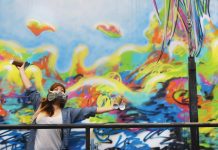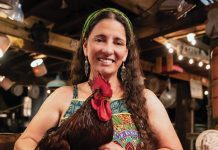
From Miami to Palm Beach, local artist Ruben Ubiera transforms blank walls into vivid works of art.
Ruben Ubiera’s vibrant images give life to static walls. His art is splattered across restaurants from Delray Beach to Boca and across blank spaces in artistic neighborhoods such as Wynwood in Miami.
Ubiera, a Weston-based artist who was molded by his upbringing in the Dominican Republic, has taken the common art from of graffiti and transformed it into a whole new genre—post-graffism. His style incorporates bold and beautiful colors. His images depict inequalities that he observed as a child and throughout his life.
The artist grew up playing in and wandering the streets of Santo Domingo in the Dominican Republic. It was there that his creativity flourished despite seeing many local artists struggle to make a living. Moving to New York as a child, Ubiera was first exposed to graffiti—what he calls the first purely American art form. He would practice the method using the influence of vibrant colors he picked up in his homeland.
Today, the 40-year-old’s work has transformed from the traditional words and tag names of graffiti to pieces that tell a story through images and colors. His work can be seen from Palm Beach to Miami, where he recently created an installation for the American Civil Liberties Union known as “#IamHere.” People can scan a bar code with their cell phone to hear a story as they view the mural.
“There is an exchange and a culture going on between the artist and the viewer,” Ubiera says. “I am careful where I place my artwork. The perception of beauty is always changing.”
After graduating from the Art Institute in Fort Lauderdale, Ubiera’s career took off when he created a mural of a massive gorilla holding a small colorful paintbrush. Showing the largest primate holding a delicate brush sent vibrations through viewers in Miami’s artistic Wynwood neighborhood. The drawing was simple, but its message was bold and powerful—Ubiera wanted traditional galleries to open up their eyes to less traditional artists such as himself.
“A gorilla has humanity,” Ubiera says. “There is nothing humane about humans at times, as history has shown.”
The gorilla motif can be seen throughout many of his pieces, which he calls “installations.” He says his works flow and contour with the surrounding spaces rather than stand in contrast to their surroundings.
This effect is noticeable in his work titled “Knowledge,” which depicts a gorilla covering the walls of a plain but pedestrian-busy alley in Lake Worth. Rather than working around the wooden fence and electric boxes protruding from the wall, Ubiera incorporated the elements into the piece to turn them into 3-D books and a music system.
In addition to his own work, local city governments in Tamarac, Lauderhill and Sunrise have invited Ubiera to enlighten public spaces with his visual art. “Murals are the fastest way to see the heart of a city,” he says.
With recent installations in Michigan and Massachusetts, Ubiera shows no signs of slowing down or limiting himself.
“I’m not going to do it like anybody else. I am going to capture my own expression,” the artist says.










Facebook Comments